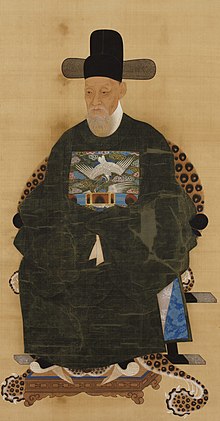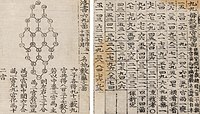| Choi Seok-jeong 최석정 | |
|---|---|
 | |
| Chief State Councillor | |
| In office 5 May 1705 – 24 April 1710 | |
| Preceded by | Sin Wan |
| Succeeded by | Yi Yeo |
| In office 27 March 1703 – 29 July 1703 | |
| Preceded by | Seo Mun-jung |
| Succeeded by | Sin Wan |
| In office 24 July 1701 – 31 October 1701 | |
| Preceded by | Seo Mun-jung |
| Succeeded by | Seo Mun-jung |
| Left State Councillor | |
| In office 12 April 1699 – 16 July 1699 | |
| Preceded by | Yi Se-baek |
| Succeeded by | Seo Mun-jung |
| Right State Councillor | |
| In office 3 April 1697 – 13 July 1698 | |
| Preceded by | Seo Mun-jung |
| Succeeded by | Yi Se-baek |
| Personal details | |
| Born | (1646-07-02)2 July 1646 |
| Died | 6 December 1715(1715-12-06) (aged 69) |
| Spouse | Lady Yi Gyeong-eok of the Yi clan |
| Children | Choe Chang-dae (son) |
| Parents |
|
| Choi Seok-jeong | |
| Hangul | 최석정 |
|---|---|
| Hanja | 崔錫鼎 |
| Revised Romanization | Choe Seokjeong |
| McCune–Reischauer | Ch'oe Sŏkchŏng |
| Art name | |
| Hangul | 존와, 명곡 |
| Hanja | 存窩, 明谷 |
| Revised Romanization | Jonwa, Myeonggok |
| McCune–Reischauer | Chonwa, Myŏnggok |
| Childhood name | |
| Hangul | 석만 |
| Hanja | 錫萬 |
| Revised Romanization | Seokman |
| McCune–Reischauer | Sŏngman |
| Courtesy name | |
| Hangul | 여시, 여화 |
| Hanja | 汝時, 汝和 |
| Revised Romanization | Yeosi, Yeohwa |
| McCune–Reischauer | Yŏsi, Yŏhwa |
| Posthumous name | |
| Hangul | 문정 |
| Hanja | 文貞 |
| Revised Romanization | Munjeong |
| McCune–Reischauer | Munjŏng |
Choi Seok-jeong (Korean: 최석정; Hanja: 崔錫鼎; 1646–1715) was a Korean politician and mathematician in the Joseon period of Korea.
He published the Gusuryak (Korean: 구수략; Hanja: 九數略) in 1700, the first known literature on Latin squares, predating Leonhard Euler by at least 67 years. He also invented the hexagonal tortoise problem. Choi was a member of the Jeonju Choe clan.
Choi Seok-jeong Award
The Choi Seok-jeong Award was created in 2021 to recognize those who develop or spread mathematics. Spelling of laureates' names matches their Misplaced Pages page, if it exists, the remainder used Revised Romanization of Korean with the Korean Romanization Converter of Al Lab and Narainfotech.
| Year | Laureates | Affiliation |
|---|---|---|
| 2021 | Kim Jae Kyoung Im Seonhui Song Hongyeop |
KAIST/Institute for Basic Science Seoul National University Yonsei University |
| 2022 | Kang Myeongju Oum Sang-il Hwang Hyeongju |
Seoul National University KAIST/Institute for Basic Science POSTECH |
| 2023 | Kim Jongam Ye Jongcheol Kim Sanghyeon |
Seoul National University KAIST Korea Institute for Advanced Study |
References
- "구수략(九數略)". 규장각 문화재청. Seoul National University Kyujanggak Institute for Korean Studies. Retrieved 11 April 2017.
- Colbourn, Charles J.; Dinitz, Jeffrey H. (2 November 2006). Handbook of Combinatorial Designs, Second Edition. CRC Press. p. 12. ISBN 9781420010541. Retrieved 28 March 2017.
- Ree, Sangwook (August 15, 2014). "Confucian scholar's discovery predates the work of Euler" (PDF). Math&Presso. Vol. 3. International Congress of Mathematicians.
- Kim, Sung Sook (2012). Orthogonal Latin Squares of Choi Seok-Jeong (PDF). History and Pedagogy of Mathematics. Archived from the original (PDF) on 5 April 2017. Retrieved 28 March 2017.
- Proceedings of the Genetic and Evolutionary Computation Conference. Morgan Kaufmann Publishers. 2002. p. 689. ISBN 9781558608788. Retrieved 28 March 2017.
- "CI Jae Kyoung Kim won '올해의 최석정상.' Congratulation!". Biomedical Mathematics Group. Institute for Basic Science. Retrieved 29 September 2022.
'올해의 최석정상' (Choi Seok-jeong award in this year) is named after Choi, Seok-jeong who was a Korean politician and mathematician in the Joseon period of Korea. This award was established 2021 to give mathematicians credit for developing and applying mathematics or spreading mathematics culture.
- "김재경 교수, 올해의 최석정상 수상". Mathematical Sciences (in Korean). KAIST. 30 November 2021. Retrieved 15 December 2022.
- 유용하 (13 December 2022). "올해의 최석정상 수상자 서울대 강명주·카이스트 엄상일·포스텍 황형주 교수" (in Korean). Seoul Shinmun. Retrieved 15 December 2022.

This Korean academic-related biographical article is a stub. You can help Misplaced Pages by expanding it. |
This article about an Asian mathematician is a stub. You can help Misplaced Pages by expanding it. |